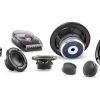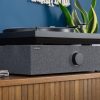As home theaters gain popularity, more and more home theater enthusiasts are carving out dedicated home theater rooms from previously unused basement space. Once reserved for Hollywood movie moguls, a home screening room is now affordable on a moderate budget. But to avoid some pitfalls that may affect novices or new homeowners dreaming about having their very own dedicated “media room,” here are some important guidelines that will help you reach your goal. These tips even apply to experienced enthusiasts who may be contemplating a move to a bigger home, or perhaps moving an existing home theater system to a different and dedicated room in an existing home.
Choose the Correct Room Shape
If possible, avoid square rooms, because deep bass sound waves really misbehave in square rooms. They produce standing waves, which result in areas of extreme bass emphasis and no audible bass. Trying to fix the standing-wave problem after the fact is virtually impossible. Instead, select a rectangular shaped room with the dimensions (length, width and height) not evenly divisible by a common denominator. For example, don’t choose a room 24 x 16 x 8 ft.; instead lay out dimensions of 23 x 13 x 7 feet. That way, you’ll minimize standing waves.
Keep the Room Size to Practical Limits
How many viewers do you expect to have? Figure out how many seats you’ll need, and of what type–real theater-type seats, or a couple of couches and recliners? Then choose a room that accommodates the furniture and provides a reasonable viewing distance versus the screen size. The larger you make your home theater, the larger the speakers and more subwoofers you’ll require, as well as having to spend more for bigger amplifiers.
Allot 50% or More of Your Home Theater Budget to Home Theater Speakers and Amplification
Don’t blow your home theater budget on a super-expensive HD projector, screen and furniture, leaving little left for home theater speakers and amplification. In other words, match your high-definition visual image with a similarly high-quality soundscape from a fine home theater surround sound system, otherwise you’ll only be disappointed at the jarring disconnect of combining a brilliant picture with lousy sound. If you spend $2,500 on an HD front- or rear-projection system, then consider spending at least $2,000 on a 5.1-channel home theater speaker setup and another $500 to $1,000 or more (depending on the room size) on an A/V surround receiver or A/V processor and amplifiers.
Compute the Screen Size and Viewing Distance
Your seating distance versus screen size will determine your sense of picture clarity and detail as well as the quality of the viewing experience. If you choose front projection, go to www.projectorcentral.com and use the Home Projector Calculator to figure out the desirable “throw” distance vs. zoom ranges for specific front projectors at various price points. Remember that DVDs currently are NOT high definition (HDTV DVD players have just started shipping), so you must have a reasonable viewing distance to get satisfying image clarity from existing DVDs. You can sit closer for true High Definition TV images, as close as twice the diagonal screen measurement. If you watch a lot of standard broadcast TV (not HD), then figure on a seating distance at least three or four times the diagonal screen measurement for acceptable image clarity.
Consider DLP or LCD Rear Projection Sets for Brighter Rooms
A DLP or LCD widescreen HDTV rear-projection set with screen sizes of 43 to 60 inches (diagonal) can produce very bright, high-contrast images in rooms with ambient light, which may suit your lifestyle better than a front projector, which requires a totally dark room. If a huge image isn’t a requirement, high-quality HDTV rear-projection DLP or LCD sets begin at about $2,500 for a 50-inch diagonal image. Flat-panel LCD and Plasma screens are also capable of delivering very bright images in a lighted room, but maximum screen size is limited to about 60 inches, unless you have an unlimited budget. Front LCD or DLP projectors are capable of 120-inch diagonal images or larger.
Can You Live With Front Projection?
A big theater-like widescreen image has undeniable impact, but using a front projector requires a dark room–totally dark–or the projected image will look washed out. Ambient room light falling on the screen will cause poor blacks and loss of shadow detail. If you are willing to arrange your room so that it can be totally darkened then a compact DLP or LCD front projector is affordable and convenient, with quite stunning picture quality. Within limits, a zoom lens lets you adjust the image size to suit the viewing distance and fit the screen.
Remember to Include the Cost of a Screen for Front Projection
Using the wall for projection purposes is possible with some special and fairly expensive paints manufactured for the purpose, but a dedicated screen will usually produce better contrast and image brightness. If you want the screen to be electrically lowered or raised out of sight, budget at least one thousand dollars for a retractable screen.
Plan on Sheetrock or Wood-Paneled Walls and a Wood or Carpeted Floor
Avoid poured concrete floors and walls, which may cause boomy and exaggerated bass. If the floor is concrete, plan on covering it with a wood sub-floor and carpet to provide some absorbency. Likewise, cement-block walls should be covered with studs and sheetrock, drywall or wood panels.
Consider Your Room Decor as Acoustical Treatment
While you don’t have to budget for expensive room “treatments” or absorbers for a home theater room, as long as you consider a normal mix of absorbent and reflective surfaces–upholstered furniture, carpet or rugs, perhaps some draperies–and some variation in wall surfaces. Bookcases or similar furniture will do nicely to prevent hard, aggressive reflections that may diminish sound quality. A room that has too many hard surfaces and is too reflective may inhibit dialog clarity and cause some occasional harshness in the treble; one that is too absorbent may diminish the natural sense of spaciousness that Axiom speakers can yield when there are some natural side-wall reflections.
Don’t Hide Floorstanding or Bookshelf Speakers Inside Custom Cabinets
Speakers already have their own enclosures (cabinets), and are carefully engineered to perform at their best in a freestanding location, unencumbered by special custom cabinets, nooks, custom shelving, or concealed in elaborately constructed cubbyholes behind special grilles. This extra cabinetry will degrade and change the neutral transparent tonal balance that Axiom speakers are noted for. At the least, deep bass performance will be uneven or boomy and hollow-sounding, and the midrange and treble tonal balance may become noticeably nasal or muddy and congested.
Resist the Urge to Use In-Ceiling Speakers
The next time you are in a cinema, look up at the ceiling. There are no surround speakers up there, right? Instead, the surround speakers line each side wall of the theater, with a couple of extra surrounds on the back wall. There are several reasons for this. The first is that human hearing is extra-sensitive to sounds arriving from each side and in front of us (that’s why our external ear structures are cupped to collect and focus lateral and front-arriving sound). Our hearing is not nearly as sensitive to spatial cues and sounds arriving from overhead and behind us. That’s why Dolby and dts 5.1-channel movie soundtracks are mixed with the surround speakers at each side and not overhead.
If you want to replicate the cinema experience and hear the surround soundtrack the way the director and audio engineers intended, do not use in-ceiling surround speakers. The effects of surround envelopment and directional cues are much more profound and convincing coming from the side walls of your home cinema. Furthermore, multichannel music recordings played with surround speakers also are more convincing with side-mounted surrounds. It’s the delay of the lateral-arriving reflected sounds that tell our ears and brain the “size” of the acoustic space we are in, so placing your surround speakers to each side, above ear level, will best duplicate how we hear ambience in real performance spaces.






























Afton Jackson
May 12, 2021 at 10:16 pm
Thank you for talking about the kinds of flooring and wall material to avoid when designing a home theater. While I want our room to be a place for everyone to enjoy as much as possible, I also want to make sure it doesn’t become a loud place that will disturb everyone else in the house. I’ll make sure to follow your tips before getting audio-visual equipment for our home theater project.